
Pasasana (Sanskrit: पाशासन; IAST: pāśāsana) or Noose Pose is an asana, a sitting meditation pose.

Pasasana (Sanskrit: पाशासन; IAST: pāśāsana) or Noose Pose is an asana, a sitting meditation pose.
The name comes from the Sanskrit word पाश, pāśa meaning "noose" or "snare", [1] and आसन, asana meaning "posture" or "seat". [2]
The pose is described and illustrated in the 19th century Sritattvanidhi ; a slightly different pose is described in the 1966 Light on Yoga . [3]
In this yoga asana, the human body creates a 'noose' when the practitioner wraps their arms around their squatting legs (from Upaveshasana) with their hands clasped behind their back, while twisting to one side. [4]

Pashchimottanasana, Seated Forward Bend, or Intense Dorsal Stretch is a seated forward-bending asana in hatha yoga and modern yoga as exercise. Janusirsasana is a variant with one knee bent out to the side; Upavishthakonasana has the legs straight and wide apart.
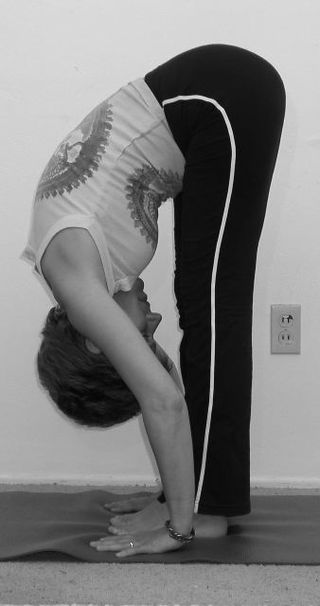
Uttanasana or Standing Forward Bend, with variants such as Padahastasana where the toes are grasped, is a standing forward bending asana in modern yoga as exercise.

Halasana or Plough pose is an inverted asana in hatha yoga and modern yoga as exercise. Its variations include Karnapidasana with the knees by the ears, and Supta Konasana with the feet wide apart.
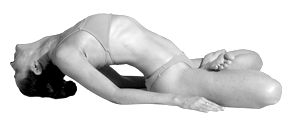
Matsyasana or Fish pose is a reclining back-bending asana in hatha yoga and modern yoga as exercise.
ShirshasanaSalamba Shirshasana, or Yoga Headstand is an inverted asana in modern yoga as exercise; it was described as both an asana and a mudra in classical hatha yoga, under different names. It has been called the king of all asanas. Its many variations can be combined into Mandalasana, in which the legs are progressively swept from one variation to the next in a full circle around the body.
Tadasana, Mountain pose or Samasthiti is a standing asana in modern yoga as exercise; it is not described in medieval hatha yoga texts. It is the basis for several other standing asanas.

Ustrasana, Ushtrasana, or Camel Pose is a kneeling back-bending asana in modern yoga as exercise.
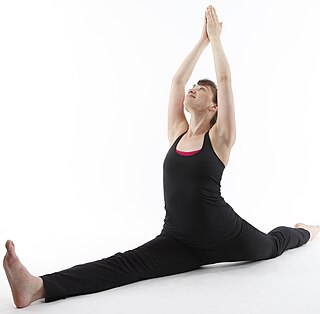
Hanumanasana or Monkey Pose is a seated asana in modern yoga as exercise. It is the yoga version of the front splits.

Virasana or Hero Pose is a kneeling asana in modern yoga as exercise. Medieval hatha yoga texts describe a cross-legged meditation asana under the same name. Supta Virasana is the reclining form of the pose; it provides a stronger stretch.

Simhasana or Lion Pose is an asana in hatha yoga and modern yoga as exercise.

Kukkutasana, Cockerel Pose, or Rooster Posture is an arm-balancing asana in hatha yoga and modern yoga as exercise, derived from the seated Padmasana, lotus position. It is one of the oldest non-seated asanas. Similar hand-balancing poses known from the 20th century include Pendant Pose or Lolasana, and Scale Pose or Tulasana.
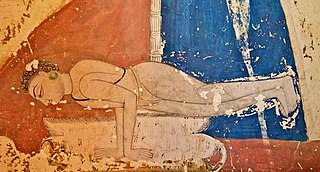
Mayūrāsana or Peacock pose is a hand-balancing asana in hatha yoga and modern yoga as exercise with the body held horizontal over the hands. It is one of the oldest non-seated asanas.

Garbha Pindasana, Embryo in Womb Pose, sometimes shortened to Garbhasana, is a seated balancing asana in hatha yoga and modern yoga as exercise.

Kurmasana, Tortoise Pose, or Turtle Pose is a sitting forward bending asana in hatha yoga and modern yoga as exercise.

Ardha Chandrasana or Half Moon Pose is a standing asana in modern yoga as exercise.
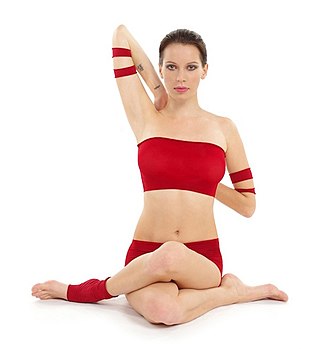
Gomukhasana or Cow Face Pose is a seated asana in hatha yoga and modern yoga as exercise, sometimes used for meditation.

Bhekasana, or Frog posture is a reclining asana in modern yoga as exercise. It is one of several poses that put the body in a shape like that of a frog: another is Mandukasana.

Koundinyasana, or Sage Kaundinya's pose, is a hand-balancing asana in modern yoga as exercise. It may be performed with both legs bent, or with one leg over the supporting arm, the other leg straight . Eka Pada Galavasana has one leg bent, the foot hooked over the opposite arm under the body.
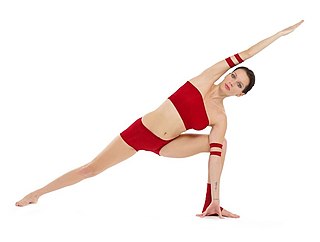
Utthita Parshvakonasana, Extended Side Angle Pose, is an asana in modern yoga as exercise. It is first described in 20th century texts.

Yoganidrasana, or Yogic Sleep Pose is a reclining forward-bending asana in modern yoga as exercise. It is sometimes called Supta Garbhasana. The name Dvi Pada Sirsasana is given to the balancing form of the pose.